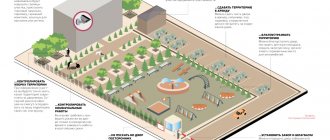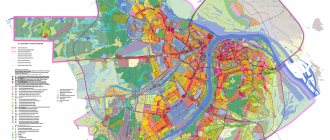A barrier in the courtyard of a house is an excellent opportunity to forget about worrying about a parking space in the courtyard of your own house. The mechanism will help avoid unwanted guests from neighboring houses or people accidentally stopping by who have business nearby. Its installation is not an easy process, but, as practice shows, it is profitable and effective.
How legal is it to install a barrier?
According to Russian legislation, the decision on the disposal of the property of shared apartment buildings is made by the majority of residents of the apartment building. The legality of installing a barrier in the yard is determined by the residents themselves, and the initiative must be approved by the majority of them at a special general meeting, the procedure for which is regulated by paragraph 5 of Article 45 of the Housing Code.
If residents decide to initiate the installation of a barrier in the yard, it is worth taking into account this resolution (notify all residents about the meeting at least 10 days before the meeting itself, document the presence of owners of more than 50% of the residential property of the house, obtain the consent of 2/3 of those who came to meeting). Otherwise, the disposal of common property will be illegal.
It is necessary that the fenced area, according to the documents, is in the local property, and is not a through road. Otherwise, there is a risk of receiving a refusal from the State Traffic Inspectorate.
If these conditions are met, it’s time to obtain permission from the fire safety authorities, the State Traffic Inspectorate and submit an application to the city administration. After approval from the above authority, the installation of the barrier will be completely legal.
How to legalize adjoining property
Ekaterina Antonova says that if the land plot on which the house is located is not registered in the cadastral register, then it automatically belongs to the municipality, which often happens in the case of old high-rise buildings.
In order to legalize adjoining property and register the right of common shared ownership, you will have to go through several mandatory stages.
- It is necessary to organize a general meeting of homeowners. The initiator does not have to be the person in charge of the house; it can be any interested person from among the owners, an initiative group or a management company. For the idea to continue, activists will need to enlist the support of at least half of the residents.
- During the meeting, a responsible person or group of persons is elected who are authorized to represent the interests of other residents.
- This is followed by an appeal to local authorities with a request to register the property in the cadastral register.
- After reviewing the application, the cadastral engineer will carry out the land surveying procedure, in other words, determine the boundaries of the land plot and draw its plan.
- The plan is sent for approval to the owners of neighboring plots and approved by the administration.
- You will receive the final version of the scheme after it has passed public hearings.
- The next stage is to submit this document to the MFC or cadastral chamber and receive a cadastral passport. Typically this process takes 10 business days.
- And finally - registration of the right of common shared ownership. This is done in Rosreestr by personally contacting the organization itself, the MFC office, or electronically. The result will be receiving an extract from the Unified State Register.
All! Now you and your neighbors are the full owners of your local area and can independently make decisions about its use, including controlling the movement of vehicles and their parking.
pixabay.com/
Cost calculation
Barrier prices, depending on the characteristics, start from 15,000 rubles. for the simplest mechanical device. A device of this type requires the additional services of a security guard, who will need to be paid a salary. His main responsibility will be to activate the mechanism when residents or ambulances, firefighters, etc. arrive. Therefore, choosing such a means of fencing is unlikely to save money. For a more reliable and easy-to-use electromechanical barrier you will have to pay from 35,000 rubles.
With design
Installing a mechanism requires taking into account many factors: resistance to external influences, safety and convenience for people passing by, physical feasibility of installation, etc. Often people are not able to make a proper assessment and resort to the services of professional engineers, which are provided by many companies in every city. The cost of installation is calculated depending on individual conditions and the barrier model, and therefore varies widely. It costs 12,000-15,000 rubles to navigate.
Subscription fee
In order for the barrier to work properly and never fail, timely maintenance is required. To carry out the service, a specialist is required, because an ignorant person can not only damage, but even completely disable complex equipment. Therefore, it is worth including quarterly professional maintenance in the cost estimate, which, depending on operating conditions, will cost approximately 500 rubles. every season.
Dispatching is more expensive and starts at 2,500 rubles. per month for remote service. The services include control of the passage of special transport (fire department vehicles, ambulances, etc.). As the responsibilities of the dispatch service expand, dispatcher costs increase accordingly.
When installing a barrier legally (that is, through a general vote of residents), each resident of an apartment building is required to pay for the maintenance of the device, regardless of his position at the meeting.
However, if the tenant does not have a car and does not want to pay extra money, he can appeal the payment decision in court. The Supreme Court will allow not to pay for a barrier if its installation was carried out illegally.
What is a local area?
Before fencing or landscaping anything, it is necessary to understand what is included in the concept of “home area,” which is rather vague for the common man. If with private country houses everything is more or less clear, although sometimes problems arise with the boundaries of the site, then with urban high-rise buildings everything is much more confusing. What is the distance from the house to the local area, who owns it and is responsible for its operation? We will try to clarify these and other questions.
Ekaterina Antonova explains that information about the local area is not clearly defined in legislative acts, but its boundaries are regulated by the following documents:
— the Town Planning Code as it relates to standardization;
— The Land Code, which designates the actual boundaries of the plot assigned to a particular house;
- Federal Law “On State Registration of Real Estate”, which regulates the process of transferring territory into shared ownership of residents of a particular apartment building;
— A registration certificate for the house and a cadastral plan for the land plot, which are kept by the person in charge of the house.
Often, when people say “home area,” they mean the courtyard in front of the entrance, but drawing such an analogy is not entirely correct. This concept is much broader than just a front garden under the windows. It necessarily includes engineering and communication structures and networks necessary for the normal functioning of all life support systems, for example, electrical substations and boiler rooms.
Thus, according to the provisions of the Housing Code, the following objects belong to the local area:
- a plot of land on which, in fact, the house itself is built;
— adjacent parking;
— fire passages;
— children's and sports grounds;
— engineering communications providing the supply of electricity, gas, water, etc.
The allocated plot of land has its own clear boundaries, which undergo mandatory state registration. Information about each specific plot, including its area, the date of transfer of ownership and its form, is stored in the State Real Estate Cadastre and reflected on the cadastral map, which can be accessed by anyone by going to the Rosreestr portal.
Why is it important to know this information, which is usually only interested in the house elder and a couple of activists? Everything is very simple: this land belongs to all homeowners, and they have the right to dispose of it at their own discretion within the framework of current legislation. For example, the area can be leased for the installation of an advertising billboard, and the income received can be spent on general needs - repair of entrances or facades, landscaping, etc.
pixabay.com/
Step-by-step instruction
To install a barrier in the yard, you need:
- Obtain the documented consent of 2/3 of the residents at a general meeting of residents of the apartment building (which must be attended by the owners of at least 51% of the property in the building).
- Obtain permission from the State Traffic Inspectorate and the Fire Safety Inspectorate.
- Submit an application for fencing the local area to the local government authority along with other documents for installing a barrier.
- Draw up a cost estimate and enter into an agreement with the company that installs barriers.
- Provide round-the-clock access to the courtyard to all residents of an apartment building (for example, using remote controls or radio key fobs), as well as special transport for the fire department, ambulance and other emergency response agencies.
Installation procedure and cost of installation work
After obtaining permission to install a barrier, it is necessary to ensure unhindered access of vehicles to special authorities and services:
- housing and communal services;
- police;
- ambulance;
- firefighters;
- gas service;
- other.
To ensure the conditions and requirements, it is necessary to hire security or a concierge, whose responsibilities will include operating the equipment. Another option for resolving the issue is to provide special services with key fobs for entering the territory of the residential complex.
Note: installation of an artificial fence should be carried out within 60 days after receiving permission from the administration of the locality.
Within a month after installation, you must send confirmation to the authorities about the completion of the work. The owner's representative submits a package of papers to the Housing and Communal Services Department:
- contract with the contractor for installation of the device;
- acceptance certificate for the installation of an artificial fence at the entrance to the courtyard of the house.
Read also: Law on garbage removal
The minimum cost of equipment installation work is 40,000 rubles. The price, first of all, depends on the type of barrier.
FAQ
There are several typical questions when installing this equipment.
Can I get a subsidy for installation?
A similar privilege exists, but only residents of the capital can count on it. To receive a subsidy for the installation of a barrier, you must contact the housing and communal services of the administrative district with the following package of documents: an application for a subsidy, a protocol of residents of an apartment building, permission from the council of deputies, a detailed project for installing a barrier device in the local area.
With the approval of the governing body, according to Moscow legislation, it is possible to cover the cost of equipment and its installation in the amount of up to 1,000,000 rubles. for one barrier. If the house is equipped with two entrances that reasonably require a barrier, then the subsidy can reach 200,000 rubles. etc.
Where and in what cases should I complain?
If residents believe that the barrier in the yard was installed illegally (without the consent of the majority of residents of the house or the fire department), they can file a complaint with the local administration, which is obliged to consider it and, if a violation is confirmed, issue a verdict on dismantling the barrier structure .
How to dismantle a barrier in the yard?
If the local government body recognizes the installation of a barrier as illegal, the responsibility for dismantling the barrier falls on the initiator of the installation. In addition, the person is subject to a fine of 1,000 rubles. up to 2000 rub. for individuals and from 10,000 rubles. up to 20,000 rub. for legal entities.
How to get the key?
If a tenant owns a share of the property of an apartment building, access to the yard must be provided 24/7, so no one can refuse him a key to the barrier. Keys are often purchased for all residents along with installation services for the device. In case of loss, you should contact the chairman of the housing fund for a copy. Or you can independently negotiate with the company that installed the device.
What documents are needed to obtain a permit?
The list of documents provided to the local administration includes:
- Application for installation of a barrier.
- Verdict of the residents' meeting.
- Documents permitting installation from Gospozhnadzor and State Traffic Safety Inspectorate.
Types of barriers
Barrier devices at the entrance to the courtyard of a residential building are divided into two types:
- Mechanical type. Causes guards to operate the mechanism manually. The equipment belongs to the economy segment, and installation takes one day. However, additional monthly costs relate to the payment of hired forces, which are responsible for allowing official vehicles into the territory. Therefore, this type of equipment is cheap only at the first stage. On average, the salary of one watchman is 15-18 thousand rubles.
- Automatic view. It operates through a hydraulic or electromechanical drive. The first type should be installed if a large traffic flow of vehicles is expected in the housing complex. The device has high throughput characteristics.
The second type runs on electricity. Opening is carried out remotely via the on/off button. Bandwidth is average. Suitable for residential complexes on 5-710-story buildings.
How can you resolve the issue if a barrier is already installed?
An emergency access device
can be connected to the barrier .
This is an acoustic detector of emergency sirens for controlling automation and bollards. In an emergency, the most important commodity is time, and once the SOS emergency access sensor detects an emergency siren, fire siren, ambulance siren or police siren, the gate will open within 3 seconds. It is the most cost-effective option for emergency access to homes or businesses and allows emergency responders to easily get through the gate without delay, eliminating the steps of entering codes, searching for keys or a remote control. The emergency siren sensor is equipped with a microphone on the front panel for faster siren detection. All news









